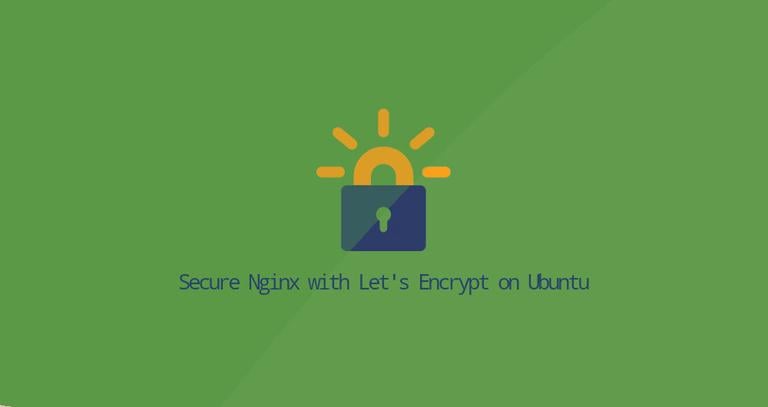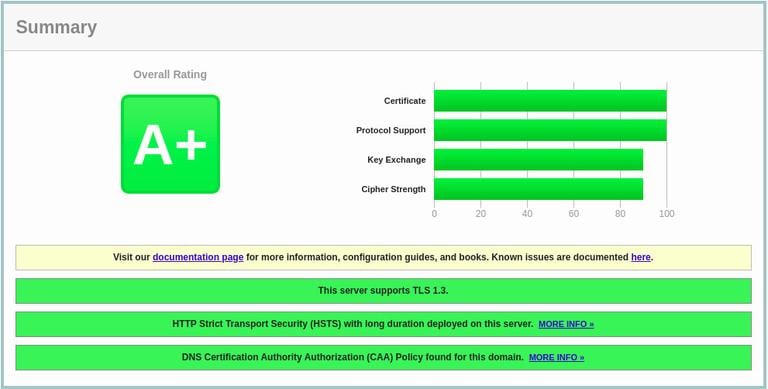Secure Nginx with Let's Encrypt on Ubuntu 20.04
Published on
•5 min read

Let’s Encrypt is a free, automated, and open certificate authority developed by the Internet Security Research Group (ISRG) that provides free SSL certificates.
Certificates issued by Let’s Encrypt are trusted by all major browsers and valid for 90 days from the issue date.
This tutorial explains how to install a free Let’s Encrypt SSL certificate on Ubuntu 20.04, running Nginx as a web server. We’ll also show how to configure Nginx to use the SSL certificate and enable HTTP/2.
Prerequisites
Before you proceed, make sure that you have met the following prerequisites:
- You have a domain name pointing to your public IP. We’ll use
example.com. - You have Nginx installed on your CentOS server.
- Your firewall is configured to accept connections on ports 80 and 443.
Installing Certbot
We’ll use certbot to obtain and renew the certificates.
Certbot is a fully-featured and easy to use tool that automates the tasks for obtaining and renewing Let’s Encrypt SSL certificates and configuring web servers to use the certificates.
The certbot package is included in the default Ubuntu repositories. To install it run the following commands:
sudo apt updatesudo apt install certbot
Generating Strong Dh (Diffie-Hellman) Group
Diffie–Hellman key exchange (DH) is a method of securely exchanging cryptographic keys over an unsecured communication channel.
Generate a new set of 2048 bit DH parameters by typing the following command:
sudo openssl dhparam -out /etc/ssl/certs/dhparam.pem 2048You can also use a key length up to 4096 bits, but the generation may take more than 30 minutes, depending on the system entropy.
Obtaining a Let’s Encrypt SSL certificate
To obtain an SSL certificate for the domain, we’re going to use the Webroot plugin that works by creating a temporary file for validating the requested domain in the ${webroot-path}/.well-known/acme-challenge directory. The Let’s Encrypt server makes HTTP requests to the temporary file to verify that the requested domain resolves to the server where certbot runs.
To make it more simple we’re going to map all HTTP requests for .well-known/acme-challenge to a single directory, /var/lib/letsencrypt.
The following commands will create the directory and make it writable for the Nginx server:
sudo mkdir -p /var/lib/letsencrypt/.well-knownsudo chgrp www-data /var/lib/letsencryptsudo chmod g+s /var/lib/letsencrypt
To avoid duplicating code, we’ll create two snippets and include them in all Nginx server block files.
Open your text editor
and create the first snippet, letsencrypt.conf:
sudo nano /etc/nginx/snippets/letsencrypt.conflocation ^~ /.well-known/acme-challenge/ {
allow all;
root /var/lib/letsencrypt/;
default_type "text/plain";
try_files $uri =404;
}
Next, create the second snippet, ssl.conf, which includes the chippers recommended by Mozilla
, enables OCSP Stapling, HTTP Strict Transport Security (HSTS) and enforces few security‑focused HTTP headers.
sudo nano /etc/nginx/snippets/ssl.confssl_dhparam /etc/ssl/certs/dhparam.pem;
ssl_session_timeout 1d;
ssl_session_cache shared:SSL:10m;
ssl_session_tickets off;
ssl_protocols TLSv1.2 TLSv1.3;
ssl_ciphers ECDHE-ECDSA-AES128-GCM-SHA256:ECDHE-RSA-AES128-GCM-SHA256:ECDHE-ECDSA-AES256-GCM-SHA384:ECDHE-RSA-AES256-GCM-SHA384:ECDHE-ECDSA-CHACHA20-POLY1305:ECDHE-RSA-CHACHA20-POLY1305:DHE-RSA-AES128-GCM-SHA256:DHE-RSA-AES256-GCM-SHA384;
ssl_prefer_server_ciphers on;
ssl_stapling on;
ssl_stapling_verify on;
resolver 8.8.8.8 8.8.4.4 valid=300s;
resolver_timeout 30s;
add_header Strict-Transport-Security "max-age=31536000; includeSubDomains" always;
add_header X-Frame-Options SAMEORIGIN;
add_header X-Content-Type-Options nosniff;
Once the snippets are created, open the domain server block file and include the letsencrypt.conf snippet as shown below:
sudo nano /etc/nginx/sites-available/example.com.confserver {
listen 80;
server_name example.com www.example.com;
include snippets/letsencrypt.conf;
}To enable the new server block, create a symbolic link from the file to the sites-enabled directory:
sudo ln -s /etc/nginx/sites-available/example.com.conf /etc/nginx/sites-enabled/Restart the Nginx service for the changes to take effect:
sudo systemctl restart nginxYou can now run Certbot with the webroot plugin and obtain the SSL certificate files by issuing:
sudo certbot certonly --agree-tos --email admin@example.com --webroot -w /var/lib/letsencrypt/ -d example.com -d www.example.comIf the SSL certificate is successfully obtained, certbot will print the following message:
IMPORTANT NOTES:
- Congratulations! Your certificate and chain have been saved at:
/etc/letsencrypt/live/example.com/fullchain.pem
Your key file has been saved at:
/etc/letsencrypt/live/example.com/privkey.pem
Your cert will expire on 2020-10-18. To obtain a new or tweaked
version of this certificate in the future, simply run certbot
again. To non-interactively renew *all* of your certificates, run
"certbot renew"
- Your account credentials have been saved in your Certbot
configuration directory at /etc/letsencrypt. You should make a
secure backup of this folder now. This configuration directory will
also contain certificates and private keys obtained by Certbot so
making regular backups of this folder is ideal.
- If you like Certbot, please consider supporting our work by:
Donating to ISRG / Let's Encrypt: https://letsencrypt.org/donate
Donating to EFF: https://eff.org/donate-le
Now that you have the certificate files, you can edit your domain server block as follows:
sudo nano /etc/nginx/sites-available/example.com.confserver {
listen 80;
server_name www.example.com example.com;
include snippets/letsencrypt.conf;
return 301 https://$host$request_uri;
}
server {
listen 443 ssl http2;
server_name www.example.com;
ssl_certificate /etc/letsencrypt/live/example.com/fullchain.pem;
ssl_certificate_key /etc/letsencrypt/live/example.com/privkey.pem;
ssl_trusted_certificate /etc/letsencrypt/live/example.com/chain.pem;
include snippets/ssl.conf;
include snippets/letsencrypt.conf;
return 301 https://example.com$request_uri;
}
server {
listen 443 ssl http2;
server_name example.com;
ssl_certificate /etc/letsencrypt/live/example.com/fullchain.pem;
ssl_certificate_key /etc/letsencrypt/live/example.com/privkey.pem;
ssl_trusted_certificate /etc/letsencrypt/live/example.com/chain.pem;
include snippets/ssl.conf;
include snippets/letsencrypt.conf;
# . . . other code
}
With the configuration above we are forcing HTTPS and redirecting from www to non www version.
Reload the Nginx service for changes to take effect:
sudo systemctl reload nginxTo verify that the SSL certificate is successfully installed, open your website using https://, and you’ll notice a green lock icon.
If you test your domain using the SSL Labs Server Test
, you’ll get an A+ grade, as shown in the image below:

Auto-renewing Let’s Encrypt SSL certificate
Let’s Encrypt’s certificates are valid for 90 days. To automatically renew the certificates before they expire, the certbot package creates a cronjob and a systemd timer. The timer will automatically renew the certificates 30 days before its expiration.
When the certificate is renewed, the nginx service needs to be reloaded. Open the /etc/letsencrypt/cli.ini and add the following line:
sudo nano /etc/letsencrypt/cli.inideploy-hook = systemctl reload nginx
To test the renewal process, run the certbot --dry-run command:
sudo certbot renew --dry-runIf there are no errors, it means that the renewal process was successful.
Conclusion
We’ve shown you how to use the certbot to download Let’s Encrypt SSL certificates for your domain. We’ve also created Nginx snippets to avoid duplicating code and configured Nginx to use the certificates.
To learn more about how to use Certbot, visit their documentation .
If you have any questions or feedback, feel free to leave a comment.


